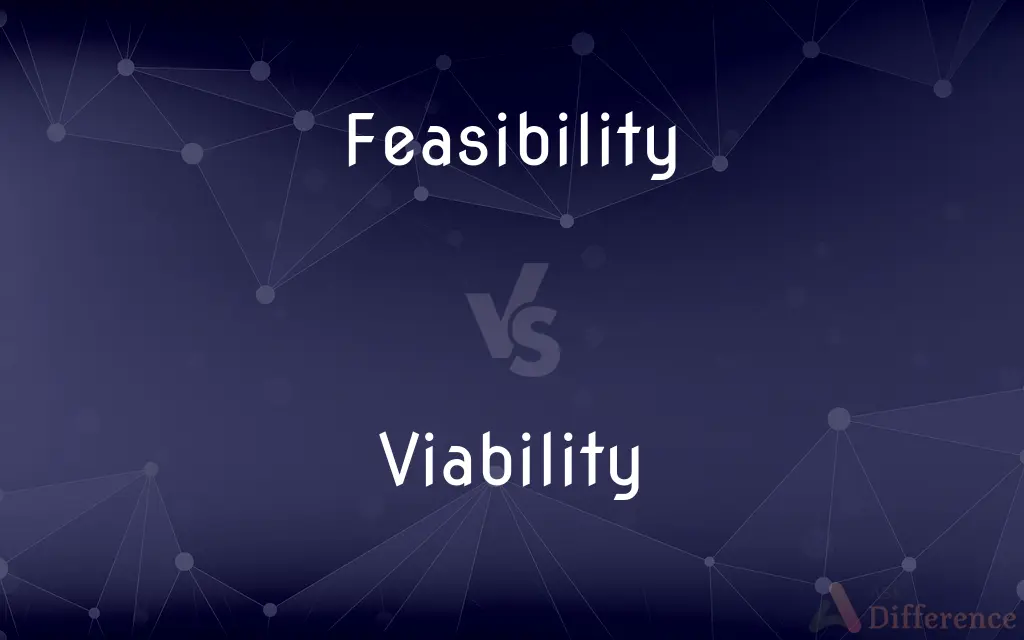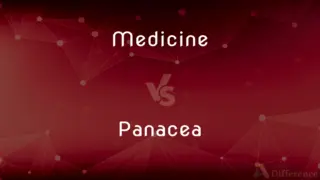Feasibility vs. Viability — What's the Difference?
By Fiza Rafique & Urooj Arif — Updated on March 25, 2024
Feasibility assesses if a project can be done given the resources, while viability evaluates its potential for long-term success.

Difference Between Feasibility and Viability
Table of Contents
ADVERTISEMENT
Key Differences
Feasibility focuses on the practicality and possibility of a project or idea, examining factors like resources, technology, and legal constraints to determine if it can be successfully completed. In contrast, viability goes beyond completion to assess whether the project or idea can sustain itself in the long run, considering market demand, financial stability, and profitability.
When evaluating feasibility, the primary concern is whether the necessary resources, skills, and technology are available to execute the project within the desired timeframe. On the other hand, viability looks at the project's potential to generate revenue, achieve profitability, and maintain financial health over time.
Feasibility studies often precede viability assessments. Initially, it is essential to know if a project is possible before exploring its potential for success. Conversely, a project might be feasible but not viable if it lacks a clear path to profitability or market acceptance.
Environmental, legal, and technical assessments are key components of feasibility studies, ensuring that a project can be undertaken without violating regulations or encountering insurmountable obstacles. Whereas viability studies focus more on competitive analysis, market trends, and financial projections to forecast the project's performance.
The outcome of a feasibility study might be a "go" or "no-go" decision based on the project's practicality, while the outcome of a viability study influences strategic decisions, such as pricing, marketing, and scaling, based on the project's potential for success.
ADVERTISEMENT
Comparison Chart
Focus
Practicality and possibility of execution.
Long-term success and sustainability.
Key Considerations
Resources, technology, legal constraints.
Market demand, profitability, financial stability.
Outcome
Determines if a project can be started.
Determines if a project should continue and how it can succeed.
Studies
Environmental, legal, technical assessments.
Competitive analysis, market trends, financial projections.
Decision Influence
Influences the "go" or "no-go" decision to start a project.
Guides strategic decisions like pricing, marketing, and scaling.
Compare with Definitions
Feasibility
It examines resources, technology, and legal constraints.
Their feasibility analysis revealed a shortage of skilled labor.
Viability
Viability evaluates a project's potential for long-term success.
The business plan's viability was questioned due to market saturation.
Feasibility
Feasibility assesses whether a project or idea can be realized.
The feasibility study concluded the new software could be developed within budget.
Viability
Viability follows feasibility in project planning.
After establishing feasibility, the focus shifted to the project's viability.
Feasibility
Feasibility is about practicality and possibility.
The feasibility of the bridge project hinged on environmental regulations.
Viability
It considers market demand, profitability, and financial health.
The startup's viability hinged on its unique value proposition.
Feasibility
The outcome often results in a "go" or "no-go" decision.
The feasibility report's findings led to a go decision on the expansion.
Viability
Influences strategic decisions like pricing and marketing.
Viability analysis influenced their decision to adjust pricing.
Feasibility
Feasibility precedes viability assessments.
Once the project's feasibility was confirmed, its viability was next to be assessed.
Viability
Viability is about sustainability and growth.
The new product's viability depended on consumer acceptance.
Feasibility
Capable of being accomplished or brought about; possible
A feasible plan.
Viability
Capable of success or continuing effectiveness; practicable
A viable plan.
A viable national economy.
Feasibility
Capable of being used or dealt with successfully
Feasible new sources of energy.
Viability
Capable of living, developing, or germinating under favorable conditions
Viable spores.
Feasibility
Logical; likely
A feasible explanation.
Viability
Capable of living outside the uterus. Used of a fetus or newborn.
Feasibility
The state of being feasible or possible.
Viability
The property of being viable; the ability to live or to succeed
Feasibility
The quality of being feasible; practicability; also, that which is feasible; as, before we adopt a plan, let us consider its feasibility.
Men often swallow falsities for truths, dubiosities for certainties, possibilities for feasibilities.
Viability
The quality or state of being viable.
Feasibility
The quality of being doable
Viability
The capacity of living after birth.
Viability
The capacity of living, or being distributed, over wide geographical limits; as, the viability of a species.
Viability
(of living things) capable of normal growth and development
Viability
Capable of become practical and useful
Common Curiosities
Can a project be feasible but not viable?
Yes, a project can be technically and legally possible to execute (feasible) but may not be profitable or sustainable in the long term (not viable).
Why is a feasibility study important?
A feasibility study is crucial for determining whether the necessary resources and conditions are in place for a project to be successfully completed.
What is feasibility in project management?
Feasibility refers to the assessment of a project's practicality, considering available resources, technology, and constraints.
What are the key components of a viability study?
Key components include market analysis, financial projections, competitive analysis, and assessment of revenue and profitability potential.
Can the results of feasibility and viability studies change over time?
Yes, changes in market conditions, technology, regulations, or resources can affect the outcomes of these assessments.
How does viability differ from feasibility?
Viability assesses a project's potential for long-term success and sustainability, focusing on profitability and market acceptance.
How do feasibility and viability studies influence decision-making?
These studies inform decision-makers about the practicality and potential success of a project, guiding "go/no-go" decisions and strategic planning.
How do financial projections influence a project's viability?
Financial projections help assess whether a project can generate enough revenue and profit to justify the investment and ensure sustainability.
What happens if a project is viable but not feasible?
If a project is viable but not feasible, it suggests that while it could be successful, current constraints or limitations prevent its execution.
What role does market demand play in viability studies?
Market demand is critical in determining whether there will be sufficient interest and sales potential for the project's outputs.
What is the significance of competitive analysis in viability assessments?
Understanding the competitive landscape helps gauge a project's potential to attract and retain customers in the face of competition.
Is it necessary to conduct both feasibility and viability studies for all projects?
While not all projects may require extensive studies, assessing both aspects is crucial for significant investments or new ventures.
How do environmental and legal assessments fit into feasibility studies?
These assessments ensure that a project complies with regulations and can be undertaken without causing unacceptable environmental impacts.
Can a project's viability improve over time?
Yes, changes in market trends, consumer preferences, or technological advancements can enhance a project's viability.
What are some common reasons a project might be deemed not feasible?
Lack of resources, technological limitations, regulatory barriers, or high costs can render a project not feasible.
Share Your Discovery

Previous Comparison
Medicine vs. Panacea
Next Comparison
ASA vs. AASAuthor Spotlight
Written by
Fiza RafiqueFiza Rafique is a skilled content writer at AskDifference.com, where she meticulously refines and enhances written pieces. Drawing from her vast editorial expertise, Fiza ensures clarity, accuracy, and precision in every article. Passionate about language, she continually seeks to elevate the quality of content for readers worldwide.
Co-written by
Urooj ArifUrooj is a skilled content writer at Ask Difference, known for her exceptional ability to simplify complex topics into engaging and informative content. With a passion for research and a flair for clear, concise writing, she consistently delivers articles that resonate with our diverse audience.
















































